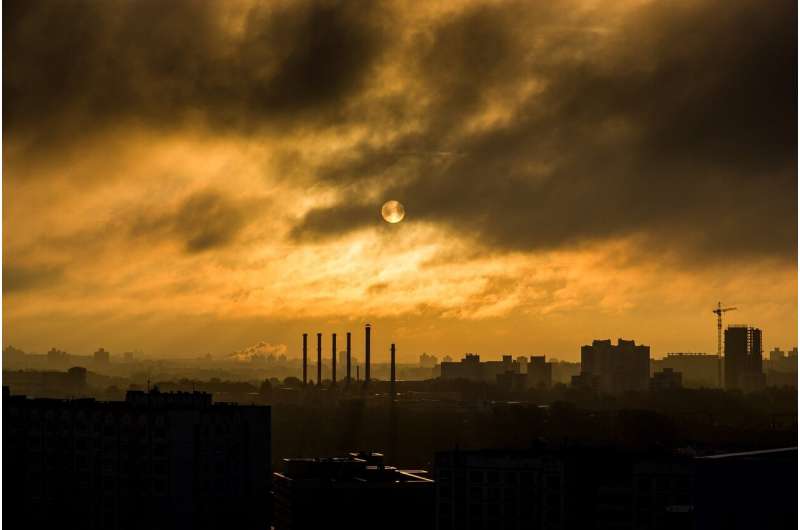Risk of death surges when extreme heat and air pollution coincide

Heat waves and air pollution are harmful, even deadly, and both are predicted to increase in frequency due to climate change. A team of researchers from USC is helping shed light on the health risks by assessing six years of air quality, temperature and death certificate data in a new study, just published in the American Journal of Respiratory and Critical Care Medicine.
The study found that compared to days without extreme conditions, extreme heat days carried a 6.1% increase in risk of death. On extreme air pollution days, deaths were 5% more likely. But on days with both extreme heat and air pollution, deaths were 21% more likely—a synergistic effect almost double the impact of the individual exposures combined.
"We found that the mortality effect of exposure to both extreme temperatures and extreme pollution is greater than the sum of their individual effects," said Md Mostafijur Rahman, Ph.D., a postdoctoral fellow in the Department of Population and Public Health Sciences at the Keck School of Medicine of USC and lead author of the study.
Previous studies have examined how extreme heat and air pollution separately affect mortality risk, and how each varies with the other. The present study is the first to use a new approach to study what happens when extreme heat and air pollution coincide.
Along with overall mortality, this study also examined deaths due to cardiovascular and respiratory conditions. On extreme exposure days, people over age 75 faced the higher risk. The findings could ultimately help individuals, communities and health care systems prepare for extreme weather and minimize potential harm.
"Understanding the risks associated with these exposures is really important, because we know that they will increase with climate change in many different parts of the United States and the world," said Erika Garcia, Ph.D., MPH, an assistant professor of population and public health sciences at the Keck School of Medicine and the study's senior author. Wildfires, for example, which are expected to increase up to 50% by the end of the century, often involve extreme heat and pollution that last for days or weeks.
The risk of extreme exposure
Garcia, Rahman and their colleagues studied all deaths in California between 2014 and 2019—a total of more than 1.5 million—using death certificate data from California's Department of Public Health. They also obtained data on air temperature and levels of fine particulate matter (PM2.5), tiny particle pollution in the air that is known to cause health problems.
They then linked deaths with local environmental conditions based on the individual's home address in order to understand effects of exposure. Using data on temperature and air pollution levels, the researchers classified each day into one of four categories: no extreme exposure, extreme heat only, extreme air pollution only, or extreme heat and air pollution.
On days with both extreme heat and air pollution, the overall mortality risk increased 21%. The risk of death due to cardiovascular problems increased 29.9% and risk of death due to respiratory problems increased 38%.
Though the researchers did not study specific causes of death, these problems typically include conditions such as heart failure and pneumonia. On days when both heat and air pollution reach extreme levels, people may have more inflammation and oxidative stress, as well as problems with regulating the body's internal temperature, Rahman said.
Older adults faced significantly higher risk, with a 36.2% increase in mortality risk for those over 75, compared to an 8.5% increase in mortality risk for people 75 and under when exposed to both extreme heat and pollution.
Keeping communities safe
The findings underscore the need for protective measures and interventions as the environment continues to change, Garcia said.
For example, local governments might combine heat and air pollution alert systems to convey that the exposures are related, and notify people to exercise increased caution when the two extremes coincide. To help people stay safe, communities can provide air-conditioned cooling centers for older adults and other sensitive groups. Long-term investments could include adding more green space, as well as pavement and rooftops built from reflective materials, to help reduce temperatures in urban heat islands.
With support from USC President Carol Folt's Presidential Working Group on Sustainability and in alignment with USC's Assignment: Earth sustainability goals, the research team is exploring ways to translate their findings into changes that will benefit communities, both in California and beyond. Future studies will explore how extreme heat and air pollution may impact mortality related to mental health, including suicide and homicide. The research team is also studying whether disparities in mortality risk are linked to measures of neighborhood deprivation.
"If certain communities face an increased risk when these exposures occur, that will highlight an important target for interventions," Garcia said.
More information: Md Mostafijur Rahman et al, The Effects of Co-Exposure to Extremes of Heat and Particulate Air Pollution on Mortality in California: Implications for Climate Change, American Journal of Respiratory and Critical Care Medicine (2022). DOI: 10.1164/rccm.202204-0657OC




















